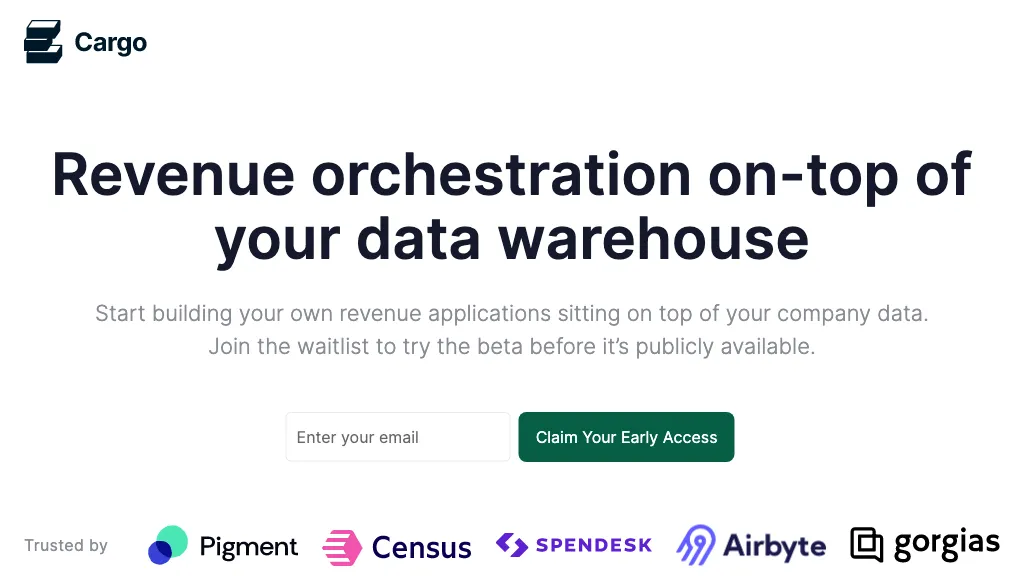What is Cargo?
Cargo is a new tool to take your data operations to the next level beyond traditional business intelligence. With Cargo, you can set up revenue operations workflows directly on top of the data warehouse. It is currently in beta and a waitlist is available for users to be added to try the product before public release.
Cargo: Key Features & Benefits
Cargo offers a wide array of features to serve users in many diversified ways. Key features include:
-
Data Visualization:
Interactively visualize your data in actionable insight to make more informed decisions. -
Data Discovery:
Effortlessly discover and find patterns or trends in your data. -
Data Integration:
Seamlessly pull together data from various sources into a single unified view. -
Automated Reporting:
Automatically produce reports and save yourself a whole lot of both time and inaccuracy. -
Revops Workflow:
Well-automate and optimize revenue operations workflows.
Benefits using Cargo for enhanced data insights, smoothened workflows, better decision-making capabilities, ease of use interfaces, automation capabilities, and all-inclusive data integrations apply.
Cargo Use Cases and Applications
Cargo has been used in many different scenarios to automate and optimize business processes:
-
Automate Sales and Marketing Workflows:
Avail efficient sales and marketing operations wherein repetitive tasks are automated. -
Streamline Customer Support Processes:
Integrate support workflows and attain improvements in customer support. -
Supply Chain Management:
Embed data to drive out the inefficiencies in the supply chain.
These would include, but are not limited to: retail, finance, healthcare, and manufacturing industries. Be it data analysts, business intelligence professionals, revenue operations teams, data engineers, or product managers, all can use Cargo to their advantage for better outcomes.
How to Use Cargo
Getting started with Cargo involves first the following steps:
-
Join the Waitlist:
A sign-up to get early access to the beta version of Cargo. -
Data Integration Setup:
Connect your data sources with Cargo to have an integrated flow of information. -
Configuration:
Unlock insights with data visualization, discovery, and automated reporting. -
Workflows:
Create and optimize your workflows in RevOps using Cargo’s intuitive interface.
Best Practice:
Your data sources should be correctly connected and refreshed on a regular basis. Take the time to learn the user interface so you can leverage the features and tools made available to you.
How Cargo Works
Cargo works by embedding itself in an already existing data warehouse and unlocking advanced data operation capabilities. Advanced algorithms and models are used in data analysis and visualization. Users can compose custom workflows. By common full-cycle workflow, it means data integration, data exploration, and visualization heading up to automated reporting via an intuitive UI.
Pros and Cons of Cargo
Like any other tool, Cargo has a few pros and possible cons:
Pros
- Rich data visualization and discovery capabilities.
- Automating reporting can save a lot of time and cut down on errors.
- Ability to build and optimize workflows for revops.
- User-friendly interface: allows users to easily perform cumbersome data operations with more simplicity.
Potential Drawbacks
- Currently in beta, so there may be some bugs; a limited number of features.
- Requires integration with already existing data warehouses, which may be a learning curve.
General users are satisfied and said that it is easy to use and has powerful features. Yet several beta testers have pointed out that there are things that need improvement.
Cargo Conclusion
Overview:
Cargo is a burgeoning platform that contains much more in the way of data operations than a standard BI. The feature set alone—well rounded and intuitive—justifies its usage; as it matures further, its users will find even more features and additions.
Cargo Frequently Asked Questions
General Questions
Q:
How do I join the Cargo beta?
A:
Via the Cargo website, you can request early access to the beta via the waitlist.
Q:
What kind of data sources does Cargo support?
A:
It supports SQL databases, cloud storage, and a lot more.
Q:
Can I use Cargo if my company is small?
A:
Yes, Cargo can be used by any business size, including small ones.
Q:
What is the kind of support for the users of Cargo?
A:
It will include documentation, tutorials, and a help center featuring FAQs in case anything is going wrong or if the user has questions about it.
Q:
Will Cargo be released for public use?
A:
Yes, after beta, with different pricing plans, Cargo will be released for public use.










